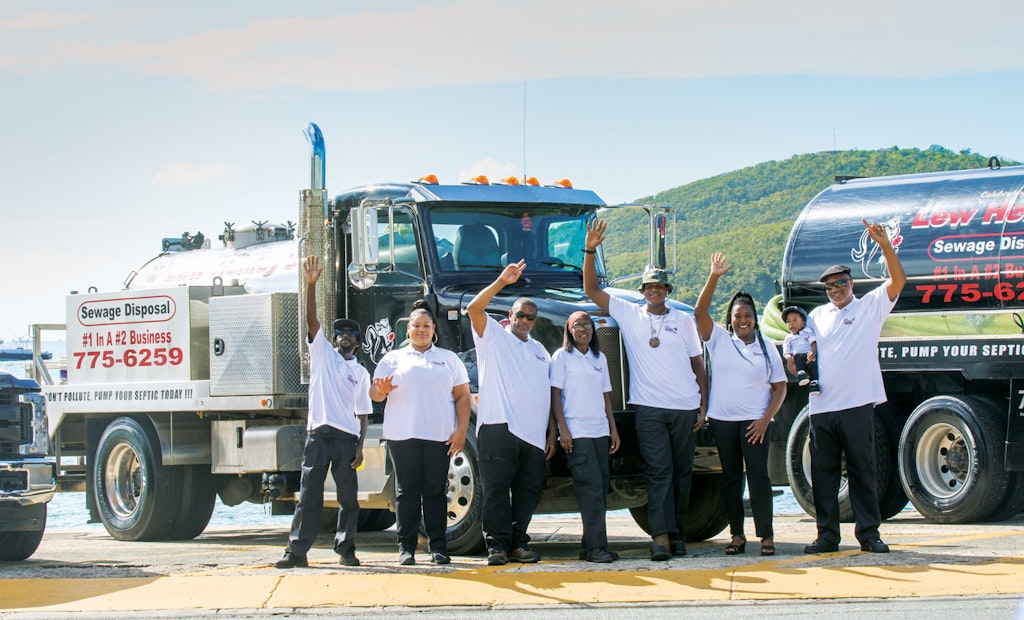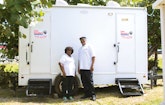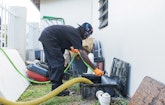
The team at Lew Henley Sewage Disposal includes, from left, Deshaun Marsan, Santineech Simon, Daniel Fleming, Deily Bussi, Loron Henley, Christine Freeland and Lew Henley holding LewMarley Henley. The trucks in the background were built out by Best Enterprises and Transway Systems. (Photos by Chalaine A. Barry-Wade)
The last thing Lew Henley expected when Hurricane Hugo slammed into the U.S. Virgin Islands in September 1989 was a game-changing boost to his fledgling septic pumping business.
But that’s exactly what happened to the entrepreneur about a year after he established Lew Henley Sewage Disposal. The business was on the ropes financially until the mammoth weather event hit the island of St. Thomas with sustained winds of 140 mph.
“I was just starting to wonder if I’d made a big mistake by starting the business, and then Hugo hit,” says Henley, 52. “There was no electrical power, so hotels couldn’t pump waste from their lift stations (to small, privately owned sewage treatment plants). One hotel asked me to pump out a lift station. Then another. And another. And so on. This went on for six months.
“It changed my life,” he adds. “I went from not making much money at all — maybe pumping two or three septic tanks a month — to getting a $100,000 check from just one hotel, which had eight lift stations that needed pumping twice a day.”
Henley promptly reinvested in his business, buying a trailer-mounted water jetter and a newer vacuum truck. Eventually power was restored to the island, but then the hotels needed someone to pump out their treatment plants and clean their grease traps. And because of Henley’s effective performance in the wake of Hugo, they called him.
“No one looks forward to a natural disaster,” he notes. “I lost my house like everyone else. But Hugo opened up a whole new world of business for me.”
Today, cleaning grease traps at hotels on the islands of St. Thomas and St. John generates about 45% of the company’s revenues, while pumping hotel sewage accounts for another 25%. Cleaning sewers and portable restroom rentals produces the remainder, Henley says.
FINDING OPPORTUNITY
Of course, it takes more than just a natural disaster to take a business from one truck to six, one employee to seven, and one service to multiple offerings. In Henley’s case, it took consistent reinvestments in equipment that either improved productivity or helped him enter new markets, a keen eye for business opportunities, and a strong work ethic.
The latter two attributes came into play early in Henley’s career. When he was 21, he was intrigued when a septic service company pumped out the septic tank at his mother’s house. Henley had just dropped out of college while pursuing a degree in business management and was looking for work.
“I asked the owner for a job, and he hired me,” Henley says. “I worked there for about 1 1/2 years and then decided to buy my own truck.”
Henley’s mother, Lucia, loaned him $8,000 — pretty much her life savings — to buy a used vacuum truck in Florida. Business was slow at first, but then Hugo hit. And in the massive rebuilding effort that followed, Henley started providing another service when he spotted a need: portable restrooms for construction companies.
“A construction company that brought in their own restrooms (10 units) asked me to pump them out,” he explains. “Then they sold (the units) to me after they left. That was my start in the restroom business.” Eventually Henley also bought restroom trailers to service special events, primarily concerts. “I had to step up to trailers because women wouldn’t use portable restrooms,” he says.
Today the company owns about 200 restrooms and 15 hand-wash stations from Satellite | PolyPortables and six restroom trailers built by Ameri-Can Engineering, JAG Mobile Solutions and Satellite Suites.
THE FLEET GROWS
The company owns six vacuum trucks built out by Best Enterprises and Transway Systems with steel, stainless steel and aluminum tanks ranging in size from 2,500 to 5,500 gallons and carrying either National Vacuum Equipment pumps or blowers, or Masport pumps. They’re equipped with jetters powered by Cat Pumps (2,000 psi at 10 gpm), which are used to clean pipelines up to 4 inches in diameter, Henley says.
Some of the trucks from Best Enterprises and Transway are custom-built with three-compartment tanks for grease, sewage and freshwater. “We had them built this way because at times we might have to provide more than one service,” Henley explains. “I don’t like plastic water tanks because if you hit something, they might leak. … It’s better to have the (metal) tank.”
In addition, the company owns five tanker trailers with aluminum and stainless steel tanks ranging in size from 3,500 to 9,000 gallons. The tankers are used for pumping out cruise ships and U.S. Navy vessels.
To clean sewers, the business relies on three combination vacuum trucks built by Vactor, Aquatech (a brand owned by Hi-Vac) and GapVax, and they feature steel debris tanks ranging in size from 10 to 15 cubic yards. For jetting nozzles, Henley prefers Warthogs from StoneAge.
For portable restroom service, the company owns a 2017 Peterbilt equipped with an 800-gallon waste and 700-gallon freshwater tank and a 2019 Ford F-550 with an 800-gallon waste and 400-gallon freshwater tank. Both were built by Best Enterprises with stainless steel tanks and Masport pumps.
Henley believes in the value of paying more money for durable, efficient equipment that features the latest technology. He cites a truck Best Enterprises is building for his company with a hot-water jetter. The end goal: better-sanitized restrooms. “Hot water kills bacteria better when used with a disinfectant,” he says. “Then we use a small leaf blower to dry the restroom instead of wiping it down and possibly spreading any remaining bacteria.”
Henley also owns a Greasezilla system that removes brown grease from grease trap waste; he then resells the brown grease as a biofuel. He also uses it to power the system, which is critical to his grease trap cleaning business because the island has no grease disposal facilities, he notes.
ANSWERING THE CALL
As the company’s reputation spread, local government officials took notice and asked Henley to clean municipal mainline sewers. The demand was great; the government did not own a vacuum truck at that time, and some of its sewer lines hadn’t been cleaned for decades, he says.
“That opened the door to buying vacuum trucks,” he reports. “I remember the first time a salesperson at the Pumper show (now the Water & Wastewater Equipment, Treatment & Transport, or WWETT, Show) showed me a GapVax vacuum truck and told me it cost about $450,000. I couldn’t imagine paying that much for a machine.
“But I eventually got to a point around 2010 where I could afford it,” he continues. “My hand was shaking when I wrote out the check for the $40,000 down payment. But it was the best investment I ever made. … It paid for itself in less than three years.” That truck is now retired.
How has service diversification helped his business? Because they’re all somewhat interrelated, they help each other out; one service call might lead customers to call again when they need a different service, Henley says.
In addition, not being reliant on just one type of work allows the company to weather cyclical ups and downs in its various markets. For example, the company currently gets more revenue from portable restroom rentals because of all the rebuilding stemming from Hurricane Maria in September 2017. “It takes a long time to rebuild things here,” Henley observes.
That’s not to say he hasn’t made mistakes along the way. For example, Henley tried to diversify into pipe lining, but ended up losing money. “I mistakenly thought that because it dealt with sewer lines, it would fit well in my business,” he says. “But I found out that it requires an entirely different skill set and mindset. So now I stick to things related to what I do and focus on doing them right.”
PRICING FOR PROFITABILITY
Buying expensive equipment is a bit riskier on a remote island with a finite population of customers (St. Thomas has about 51,000 residents). It takes a lot of jobs to generate enough revenue to pay for a vacuum truck. And the shipping charges for a large commercial vehicle run about $20,000, Henley explains.
Henley has learned he has to charge more per job to make payments on expensive equipment and cover other overhead costs. “I attended a seminar at a Pumper show 20 years ago about understanding the costs of doing business … and I learned one of the keys to being successful is charging enough to cover your expenses,” he says.
“Before that, I thought my prices should be based on competitors’ prices,” Henley continues. “I learned how to figure out my operating costs — break them down to monthly and even to daily and hourly. That opened my eyes and changed the world for me. After that, I no longer felt bad about charging a higher price than my competitors.”
Too often, contractors feel they can’t charge higher prices than competitors. But not doing so runs the risk of either not being able to pay for staples like truck maintenance and repairs, new tires and so forth — or even going out of business completely, he says.
How does he handle price objections from customers? Henley explains that he has to cover his expenses and points out companies that undercut on price typically don’t stay in business very long. He also points out that his company will arrive with newer, reliable equipment and with technicians wearing uniforms and using laptops to create invoices and process credit card payments. In a word, it’s all about professionalism.
“Then you have to provide great service,” he adds. “Once you get new customers on board, they’re yours. Not being the cheapest guy has been a big part of my success.”
STEADY GOING
Henley says his company has more or less hit a growth plateau. But that doesn’t mean the company can’t grow more. “You never know what’s around the corner,” he says.
Henley is turning his thoughts to the company’s future. Most of his eight children are now adults, and none are interested in running the business when he retires. “And that’s fine with me,” he notes. “It’s good for them to be independent and do their own things.”
Selling the company would be difficult, especially since it bears his name. “I guess I could change the name,” he says. “I just don’t want my name on trucks owned by someone else.
“When the time comes, I don’t know what I’ll do — that’s a hard one,” he adds. “But in the meantime, I’ll keep moving with it — keep things going.”










